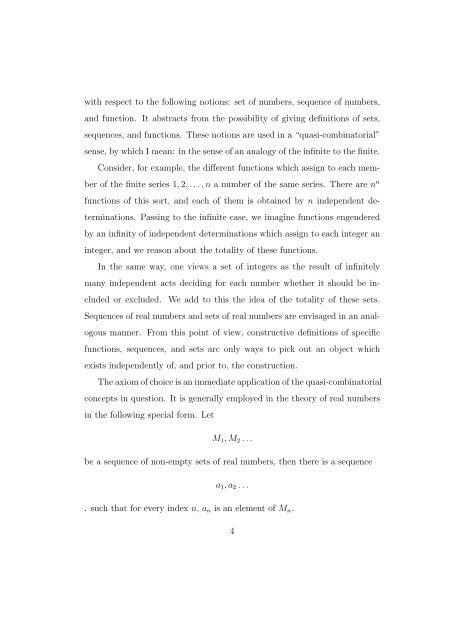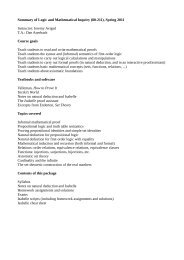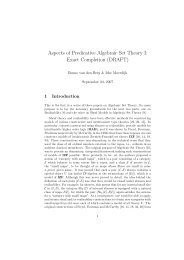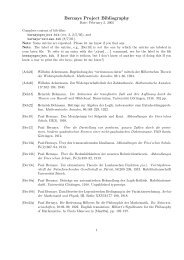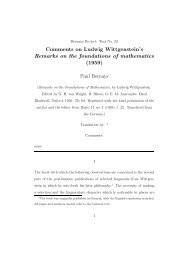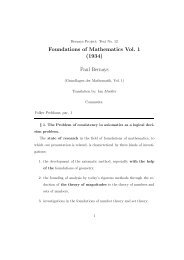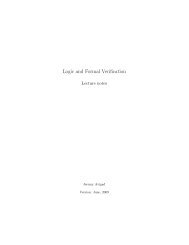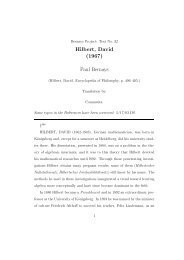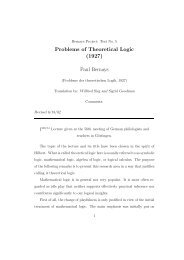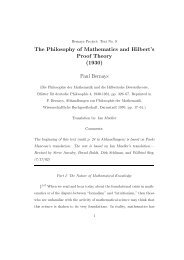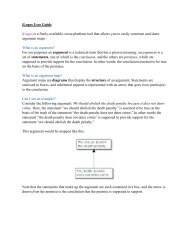Platonism in mathematics (1935) Paul Bernays - Phil Cmu
Platonism in mathematics (1935) Paul Bernays - Phil Cmu
Platonism in mathematics (1935) Paul Bernays - Phil Cmu
You also want an ePaper? Increase the reach of your titles
YUMPU automatically turns print PDFs into web optimized ePapers that Google loves.
with respect to the follow<strong>in</strong>g notions: set of numbers, sequence of numbers,<br />
and function. It abstracts from the possibility of giv<strong>in</strong>g def<strong>in</strong>itions of sets,<br />
sequences, and functions. These notions are used <strong>in</strong> a “quasi-comb<strong>in</strong>atorial”<br />
sense, by which I mean: <strong>in</strong> the sense of an analogy of the <strong>in</strong>f<strong>in</strong>ite to the f<strong>in</strong>ite.<br />
Consider, for example, the different functions which assign to each mem-<br />
ber of the f<strong>in</strong>ite series 1, 2, . . . , n a number of the same series. There are n n<br />
functions of this sort, and each of them is obta<strong>in</strong>ed by n <strong>in</strong>dependent de-<br />
term<strong>in</strong>ations. Pass<strong>in</strong>g to the <strong>in</strong>f<strong>in</strong>ite case, we imag<strong>in</strong>e functions engendered<br />
by an <strong>in</strong>f<strong>in</strong>ity of <strong>in</strong>dependent determ<strong>in</strong>ations which assign to each <strong>in</strong>teger an<br />
<strong>in</strong>teger, and we reason about the totality of these functions.<br />
In the same way, one views a set of <strong>in</strong>tegers as the result of <strong>in</strong>f<strong>in</strong>itely<br />
many <strong>in</strong>dependent acts decid<strong>in</strong>g for each number whether it should be <strong>in</strong>-<br />
cluded or excluded. We add to this the idea of the totality of these sets.<br />
Sequences of real numbers and sets of real numbers are envisaged <strong>in</strong> an anal-<br />
ogous manner. From this po<strong>in</strong>t of view, constructive def<strong>in</strong>itions of specific<br />
functions, sequences, and sets arc only ways to pick out an object which<br />
exists <strong>in</strong>dependently of, and prior to, the construction.<br />
The axiom of choice is an immediate application of the quasi-comb<strong>in</strong>atorial<br />
concepts <strong>in</strong> question. It is generally employed <strong>in</strong> the theory of real numbers<br />
<strong>in</strong> the follow<strong>in</strong>g special form. Let<br />
M1, M2 . . .<br />
be a sequence of non-empty sets of real numbers, then there is a sequence<br />
a1, a2 . . .<br />
. such that for every <strong>in</strong>dex n, an is an element of Mn.<br />
4


